But how sweet Venice is!
The knowledge of a place also passes through its gastronomic culture, you know. And when we talk about Venetian cuisine we always think of salty dishes, wines, often forgetting about pastry. But the Venetian pastry shop is full of preparations and products that come from very ancient traditions, some even dating back to the times of the Serenissima. Yes, because Venice made the acquaintance of sugar very early: arrived in the Lagoon after the Crusades of the twelfth century, it was traded by the noble family of Giorgio Corner who owned entire sugar cane plantations in Cyprus, where reigned his daughter Catherine Corner, who became Queen of Cyprus, Jerusalem and Armenia for having married James of Cyprus. The raw product was then processed and refined in their home on the Grand Canal, Ca' Corner. However, it was a rather expensive ingredient and therefore made the preparations in which it was introduced not cheap, but rather, the sugar became a true symbol of wealth and opulence, of commercial power.
The Venetian cusine and pastry could be defined as fusion, because they were always the result of multicultural crossbreeding thanks to the commercial vocation that the Republic had always had: the conquest of the Eastern Seas had brought the Venetians to know completely new peoples and customs, but also products still unknown at the time.
Among these were certainly the spices: from the Latin species, they indicated something special and at the time also very valuable and therefore expensive. These species brought new flavors and refined perfumes to the lagoon that were skillfully inserted in the gastronomy by the Venetians. If you want to learn more, or even try your hand at cooking, The flavours of Venice is a very useful read and an excellent starting point.
Anyway, From the lands of the East came cinnamon and black pepper, cloves and ginger, vanilla and nutmeg, pine nuts and sultanas. All perfectly recognizable still today in the Venetian pastries, remained almost unchanged over the centuries as the atmosphere of the most charming places of the city. Today we discover together the 7 most famous Venice sweets, the works of the most skillful scaleteri.
Benefiting from the Venice Pass, you can easily explore the monuments and the main tourist attractions Venice is sprinkled with.
Visit Venice with Venice Pass
7. Fritoe
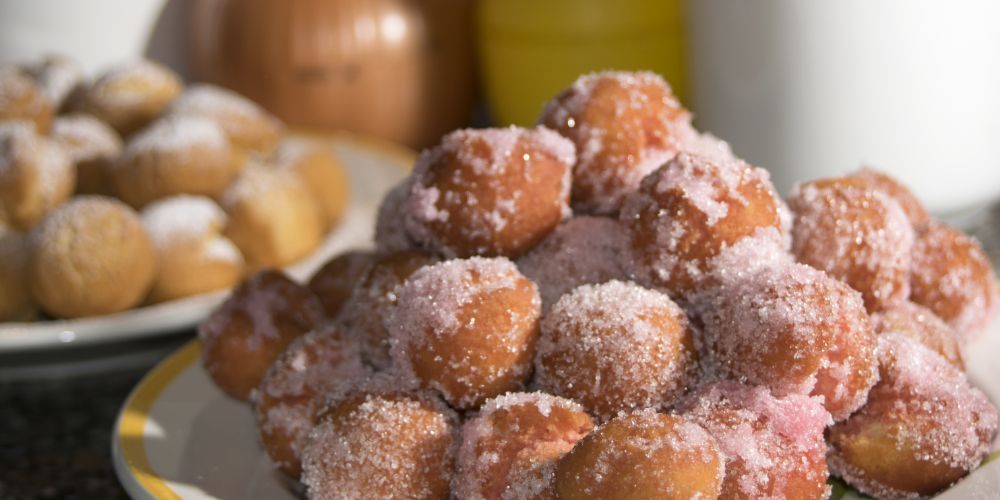
The fritoe, or pancakes, in the days of the Serenissima were a very serious matter, to the point that they became National State Sweet. Linked to the Carnival celebrations, today you can find them in the bakeries of the city almost all year round. Sweet, soft, fragrant, tasty and sugary, fritoe seem to have an ancestor in the globulos of ancient Rome, when the inhabitants of the Empire used to celebrate the Saturnalia celebrations with these little morsels prepared with durum wheat and cheese, then fried in pork fat and sweetened with honey.
When they arrived in Venice these little delicacies underwent some variations that adapted to the times and to the knowledge of new products. Honey, for example, gave way to sugar, and cheese with pine nuts and raisins, not fresh ingredients that increased the shelf life of the finished product. Pancakes, then, became a real "affair of state" and think that the makers, the fritoleri, were even grouped together in the Guild of Magdalene that counted 70 members: each of them had its own wooden hut and a specific place in the city where to practice the profession, assigned by the Republic. Think of the intoxicating scent that was spreading through the corns at the time...
The recipe of this delicious Venetian dessert was obviously the same for everyone, and since then it has remained unchanged: eggs, flour, sugar, butter, pine nuts and raisins. This original recipe is kept in a document dating back as far as the fourteenth century, currently kept in the Casatenense Library in Rome.
Tasting fritoe inevitably means getting your fingers dirty with sugar, and you must lick them to enjoy their flavor to the last!
6. Venetian pinsa
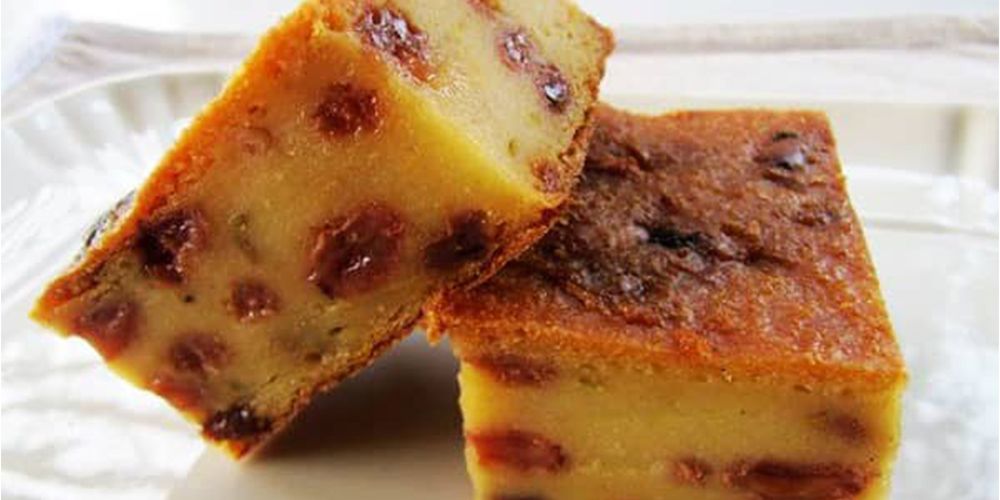
The Venetian pinsa is a sweet of the peasant heritage. It was made, in fact, in the fields, putting together simple ingredients, often recycling leftovers. It was obtained, and is still obtained today, a dough as low as a pizza, from which the name seems to derive, humid inside and rich in flavor, rustic and really fragrant. The original dough, made of flour, stale bread, eggs, butter and sugar, was then enriched with fennel seeds, honey and dried fruit, such as pine nuts, raisins and figs.
In Venice, the pinsa is called marantega cake, because it is the typical dessert of the first days of the new year and of the festivities of the Befana, in Venetian called marantega. And this is certainly not by chance! In fact, in the Venetian peasant tradition on the eve of the Epiphany it was customary to prepare propitiatory pyres to greet the old year and welcome the new one.A rite that came from afar, when this tradition coincided with the winter solstice, until the Middle Ages when the figure of Epiphany was chosen to impersonate the old who goes away and the new who arrives.
During these bonfires in the Veneto countryside, people ate pinsa and drank mulled wine, and set fire to the old, old objects that they wanted to get rid of and not bring in the new year. But it was obligatory to pay attention to the direction that the sparks took: if they flew towards the East the year would have been prosperous with abundant harvests, if towards the West the year would have been disastrous, just as this nursery rhyme says:
Pan e vin, la pinsa sotto il camin
Faive a ponente, panoce gnete
Paive a levante, panoce tante
( Bread and wine, the pinsa under the fireplace
Sparks to the west, cobs nothing
Sparks to the east, many cobs)
Undertake an engaging and tempting culinary tour through Venetian delicacies and the typical flavours of street food with a Visit Italy ticket.
5. Bussolà burenelli
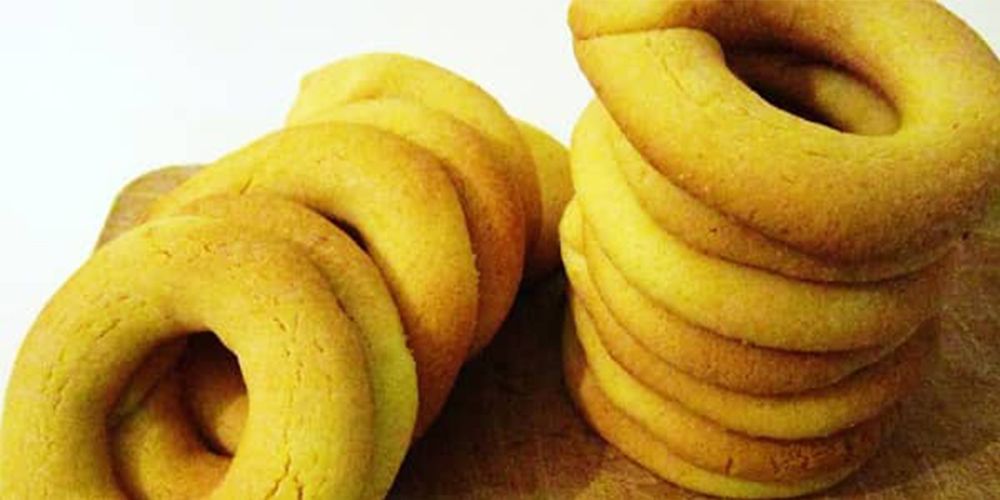
Arriving in Venice and not tasting the bussolà is a real crime!
Typical of the polychrome island of Burano, they have rigorously the accent on a, and are crumbly, good and fragrant cookies. They were born, not even to say it, at the time of the Serenissima as a gesture of love of the wives of sailors, careful to prepare to their husbands forced to stay at sea for long periods, substantial dishes that had a rather long shelf life, lacking the refrigerator at the time. And these cookies had all the characteristics to be really very nutritious, a real source and a reserve of energy: they were prepared, in fact, with a large amount of butter and eggs. But really a lot!
Few ingredients but of substance: flour, butter, eggs, sugar and vanilla scent. From their preparation, an intoxicating scent was released among the small buranelle calluses that sweetened the air. Legend has it that grandmothers used to enclose the bussolà in cotton bags and use them to perfume the linen of their chests: do not be surprised if in some drawer of a Venetian grandmother you find crumbly and fragrant cookies.
The bussolà were originally given the shape of a donut from whose hole, busà in Venetian dialect, derives its name. But over time the S shape was added to this, designed by a baker who thought they were so much easier to mogiare (to soak) in milk.
Today in the windows of Venetian pastry shops and bakers you can find both versions, which over time have also been enriched with tasty ingredients such as dried fruit and chocolate drops. But the taste and smell of this excellent Venetian pastry has remained unchanged!
Visit Murano, Burano and Torcello
4. Beans of the dead
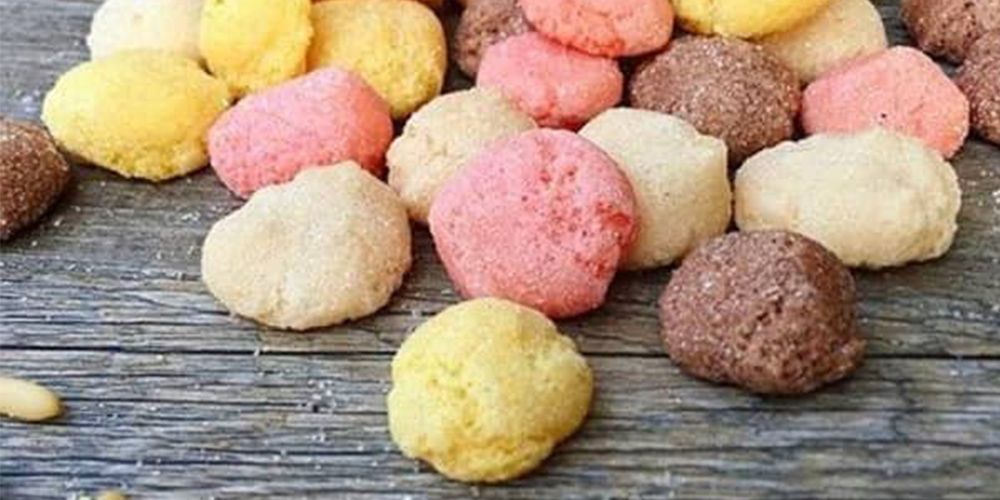
The beans of the dead, as the name says, are little sweets that are consumed especially on the day of the anniversary of the dead, November 2. They are prepared by kneading only 3 simple ingredients: egg white, sugar and pine nuts (or almonds). To these must be added specific aromas that then give the classic color: vanilla for white beans, alchermes for pink beans and cocoa for brown beans.
You will have understood that the name has nothing to do with the legume. But then why are they called this way? The reasons are different, but let's start with the oldest tradition. In Roman times, all over the Mediterranean air, beans were thought to be linked to the afterlife, symbolizing the souls of the dead. They were therefore often used for propitiatory and superstitious rites. This custom was not lost even with the arrival of Christianity when the beans were left on window sills to be consumed by the souls of the departed loved ones.
Even in the times of the Serenissima the beans were linked to the world beyond: in the last centuries of the Republic, in fact, especially after the funeral of the Venetian nobles in the kitchens of the convents that benefited from the generous donations of the rich dead were boiled large quantities of beans that were then distributed to the poorer people. They were called just beans of the dead.
This custom was lost in the centuries and the offering of the beans was relegated to November 2 only. But in fact a boiled broad bean is not a great feast for the palate. So sugar was added to sweeten the flavor and then a marzipan mixture. Over time the real bean disappeared giving way to a pure pastry dough.
Today the beans of the dead are the gift that every boyfriend gives to his beloved on November 2. But this tradition has its roots in an ancient legend that tells of Candido, a young sailor embarked for the East who had left Lucia in Venice. In Thessaloniki the young man came across a field of broad beans, a product completely unknown to him: he was so impressed that he chose to give it as a gift to his beloved. But Candido had not come to terms with the amount of time that the return trip would take, and so when he was in the presence of the young Lucia and her family the gift was terrible to the eye and nauseating to the sense of smell. It was November 1st and on the evening of that same day to make up for it Candido paid homage to his beloved with some tasty sweets.
And this is how, on the day of the dead, the modern Candido offered their Lucia some tasty and colorful broad beans, in the name of eternal love.
3. Fugassa
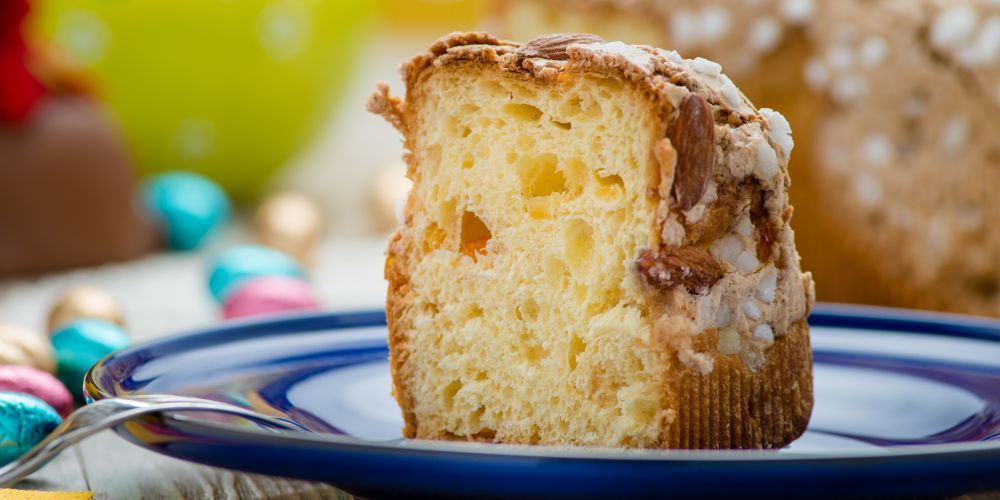
The fugassa, as the Venetians call it, is a very simple but very tasty cake, characterized by a very soft, well leavened dough: a cloud that melts in the mouth.
For its origin we must go back to the fifteenth century when, thanks to the intuition and resourcefulness of a baker from Treviso, it became a typical Venice dessert of Easter celebrations. This man, whose name has remained unknown, inspired by the Christian currents that arrived in Veneto from the distant Alexandria of Egypt thanks to the merchant trade, thought to enrich the simple bread consumed daily with eggs, sugar and butter.
This addition operation is clearly oriental, since it was in those lands that sweet bread and sugar were consumed, and the use of eggs as a symbol of spring and rebirth in the sign of the Resurrection of Christ. And it was for this reason that the consumption of this new preparation was reserved exclusively for Easter days, also because these added ingredients had a rather high cost and were not immediately available. So for the poorest people it became a typical holiday cake, which had to be consumed exceptionally and not daily. But love must always be celebrated and a few centuries later the fugassa became a treasure chest for the ring that engaged couples gave to their brides in the days of their engagement. And from the engagement to the wedding the step is short, you know, and this cake covered with white crystals of sugar, became the silent, tasty and inevitable witness of the banquets that celebrated the love unions, so much so as to become a symbol of the wedding: it was decided "beato ti che ga ancora la fugassa col zuchero sopra" (blessed you who still have the fugassa with sugar on it) metaphor in Venetian language of a marriage celebrated recently, so that the sugar has not yet had time to melt.
With the years in the hands of the Venetian stewards the fugassa has been renewed and enriched with new aromas, while retaining its characteristic of simplicity. It is the addition of an icing made with sugar and egg whites and almonds on the surface that brings the fugassa closer to the Milanese panettone, bringing its consumption also at Christmas and throughout the winter, until the Easter period. But wary of imitations, the Venetian fugassa has a very strong identity of its own.
Soft as a pandoro, dressed as a panettone, as good as every cake must be, as rich as only a page of Venetian history can be, because innovating is fine, but history and tradition remain sacred and do not touch!
2. Zaeti
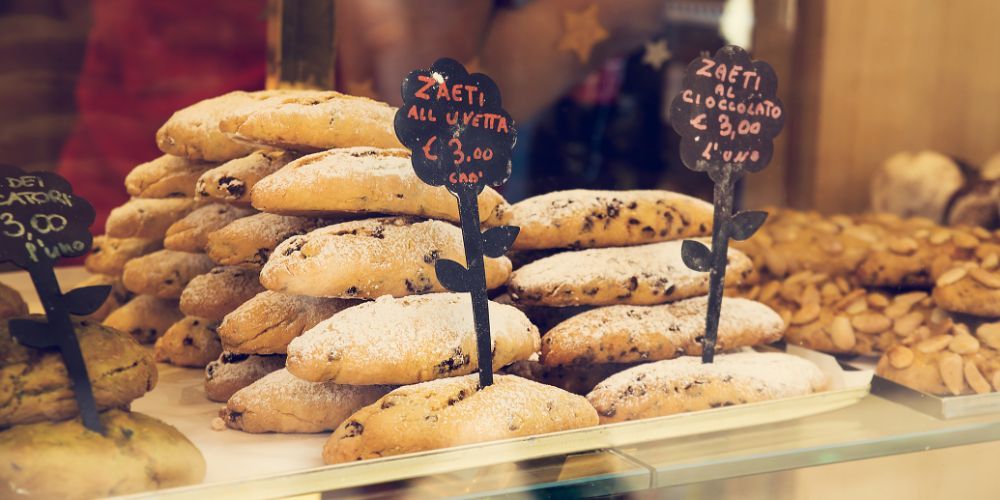
The zaeti, or zaleti, are small very crumbly cookies with a rhomboidal shape, prepared with corn flour and raisins. And this flour is the main ingredient to which we owe the name: being yellow in color, zalo in Venetian, gives the cookies this particular color.
Its granular texture, instead, gives the dough a unique degree of friability. The zaeti make their appearance in Venetian kitchens in a very remote time: the first to talk about it was, just think, the playwright Carlo Goldoni, who in his work La buona moglie (The good wife) of 1749 recommended them in combination with a good liqueur wine. But the original recipe of these Venice desserts appears for the first time in the early nineteenth century in the book La nuova cucina economica (The new economic cusine) by Vincenzo Agnoletti.
Few ingredients: corn flour, eggs, butter, sugar and raisins. Then cut into the shape of turbot they were, once cooked, covered with powdered sugar. Since then the recipe has never changed and the zaeti are still prepared in the same way today as then. Try the goodness of these appetising Venetian sweets!
1. Fried cream
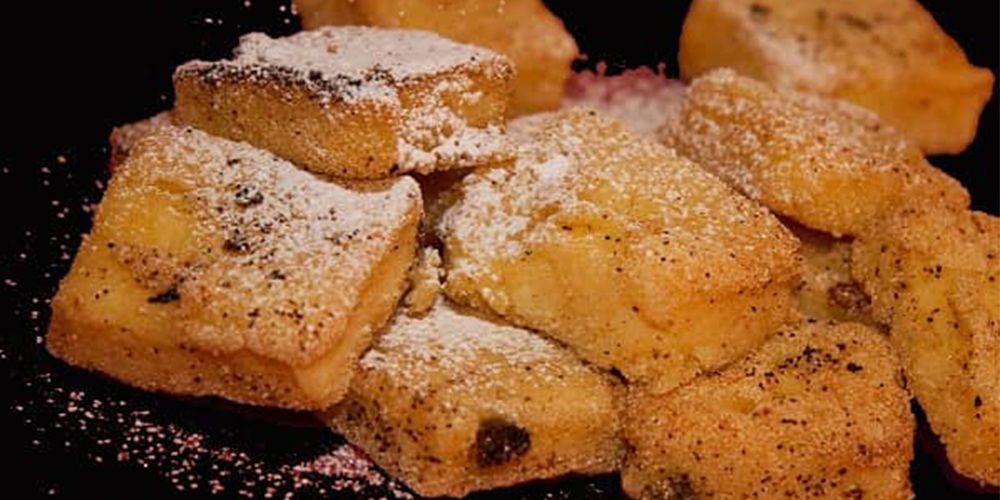
Today called fried cream, once the rumble of the doges: it is a small morsel of pure flavor, a small rumble of breaded and then fried custard. The result is a very crunchy casket that contains a soft and velvety cream that melts in the mouth: a cross between two completely different consistencies that manage to find an incredible balance in their union.
It was born as a "recycled" dessert to be able to consume the leftovers of custard. It's the best dessert in Venice that accompanies the whole winter period, from Christmas to Lent, passing through Carnival.
If you want to enjoy exploring Venice through all its gastronomic delights, don't forget to book one of the wonderful hotels you can find in the centre. Palazzo Keller, for example, also offers an excellent breakfast.
Taking advantage of the fantastic ticket offered by Visit Italy, you could participate in a refined gala dinner in the prestigious setting of a magnificent Venetian theatre. Spectacular and exciting performances by prominent singers, acrobats, dancers, and musicians of international fame will enliven the evening.
Discover Venice Dinner ShowThe pastry shop Rosa Salva, the jewelry of desserts
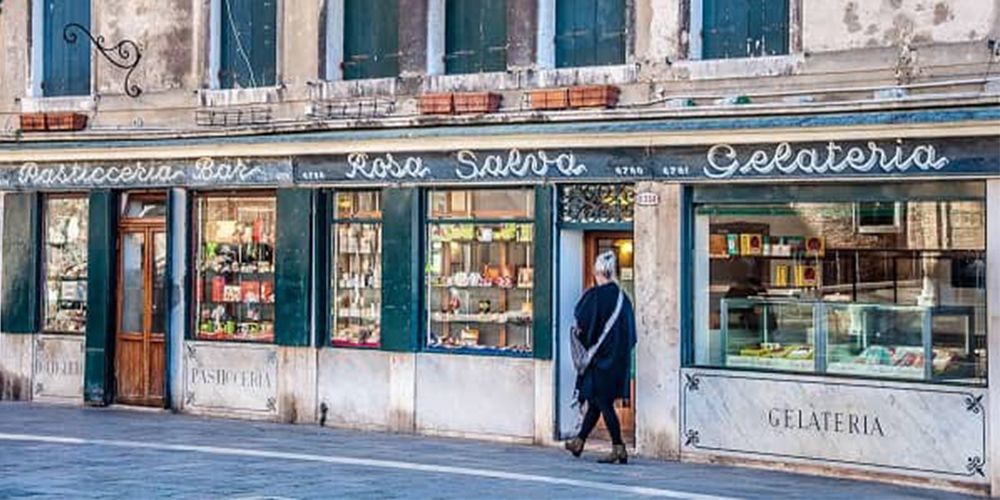
Did I tease your taste buds? Good! Now however it is necessary to pass from the words to the facts: it is necessary to taste, to taste and maybe to make stock of the best desserts in Venice to take home!
The right place is the pastry shop Rosa Salva, excellent reality of the Venetian confectionery art. Founded back in 1870 by the resourcefulness of Andrea Rosa to whom we owe the enlightening idea of having reinvented himself as a chef at home in the noble palaces of Venice and the surrounding area: thus was born what today we commonly call catering/banketing service. It was then his son Antonio, who was given the nickname of Salva, a few years later to affirm and increase the prestige of the family business becoming chef of the royal house.
Still today Rosa Salva is a point of reference of excellence in the gastronomic panorama of Venice, especially for the art of confectionery: an activity that masterfully combines tradition and innovation.
The high quality of Rosa Salva products comes from the scrupulous and rigorous selection of ingredients and raw materials, which are the basis of a scrupulous, artisan production process, today as yesterday. Added to this are technique and creativity, essential guides for the realization of a fascinating harmony of taste, which has allowed its scaleteri to win many prestigious national and international awards.
In their pastry shops, located in various parts of the city, you will be welcomed by the lively polychromy of the many products that fill the windows, in a mixed atmosphere between ancient and modern, between well-being and tranquility.
Visiting one of Rosa Salva's pastry shops means tasting traditional sweets steeped in history, such as bussolà and zaeti, and moggiarli in a hot coffee or in a cup of excellent homemade zabaglione cream, as well as sugaring your hands eating fried cream and fritoe which are made in the shape of a doughnut to optimize their cooking.
The most gluttonous will be teased by the presence of the specialties described above and fascinated by the variety and beauty of chocolate pralines with the most varied fillings, for all tastes. Impossible to renounce to the variety of homemade ice cream, to be enjoyed in the most classic flavours or in the most unusual ones, strictly with lots of whipped cream.
Study and research have led, in recent years, to the development of modern techniques and contemporary products inspired by the great patissiers français: to traditional products have been added cakes and single-portions glazed, unusual flavours and different consistencies, from soft to crisp, from soft to ethereal, designed and made as true works of architecture, satisfying for the eyes and the palate, on the other hand the pastry shop must create wonder!
It is quite easy to immerse yourself in the sugary world of Rosa Salve, thanks to the four locations in town, all central and easy to reach: between an exhibition and a walk, the ideal place to make a pleasant stop.
Rosa Salva is a journey not to be missed in the confectionery art of yesterday and today, between technique and passion, between tastes and sensations that you can remember: the pastry shop is the jewelry of the culinary art, and Rosa Salva is a treasure chest full of jewels.
These are the headquarters of Pasticceria Rosa Salva
Campo Santi Giovanni e Paolo 6779, Cannaregio Calle Fiubera 950, San Marco Gran Teatro La Fenice, Campo Fantin 1965, San Marco Via Cappuccina 17, Mestre For more infoAbout the author
Written on 11/04/2024




Imma Garofalo
The Venetian pastry shop is rich in preparations from ancient traditions, some dating back to the Serenissima. Here are the 7 most famous Venetian desserts.